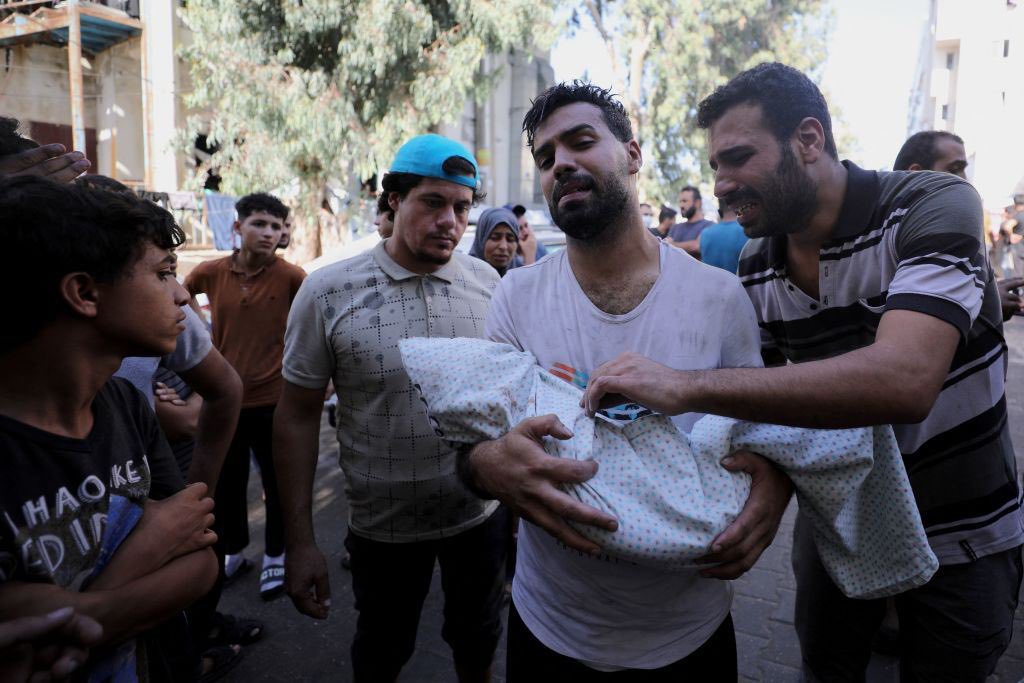On Saturday, the Palestinian Ministry of Health in Gaza reported that 9,572 have been killed and more than 26,000 wounded during the Israeli aggression against the Palestinian civilian population in Gaza and the West Bank.
The Ministry added that 9,425 were killed in the Gaza Strip, and more than 25,000 were injured, and in the West Bank the number of civilians killed rose to 147, and the wounded to more than 2,200. More than two-thirds of those killed are children, women and the elderly.
Palestinian girl screams from underneath the rubble after her house was hit by an lsraeli air attack in Gaza. pic.twitter.com/0BVtXhEerT
— TIMES OF GAZA (@Timesofgaza) November 4, 2023
The ministry said that the ambulance convoy evacuating patients from Al-Shifa Hospital in Gaza City towards the Rafah crossing was subjected to Israeli bombing three times, leading to the death of more than 15 citizens, the injury of dozens, and the destruction of a number of vehicles.
The Ministry also reported that one of the electrical generators in Al-Shifa Hospital stopped working due to a lack of fuel, and another generator is still working and covers about half of the needs of the hospital, which is one of the largest hospitals in the Gaza Strip and treats thousands of patients and hosts thousands of displaced people. The main electrical generator of the Indonesian Hospital in northern Gaza also stopped working due to lack of fuel.
The Ministry pointed out that the Jerusalem and Indonesian hospitals were subjected to bombing and air strikes, which led to a large number of killed and wounded, stressing that 16 out of 35 hospitals stopped working as a result of the Israeli bombing and the depletion of fuel.
In addition, doctors are still forced to perform surgeries without anesthesia, including those who were injured as a result of the bombing and women who give birth by caesarean section.
Since October 7, the Israeli occupation authorities have prevented patients from leaving the Gaza Strip for treatment in Jerusalem hospitals and within the 1948 territories, including 2,000 patients with cancer.
As of October 29, about 1,950 citizens were reported missing, including at least 1,050 children, who may be trapped or martyred under the rubble waiting to be recovered.
The Ministry of Health said that the Civil Defense raised the issue of the decomposition of bodies under collapsed buildings, amid limited rescue missions, which raises humanitarian and environmental concerns, pointing out that humanitarian agencies and their employees faced major restrictions in providing humanitarian aid due to the ongoing aggression, restrictions on movement, and shortages of electricity, fuel, water and medicines.
The Palestine Red Crescent Society announced a reduction in the number of ambulances it operates, and all humanitarian agencies and their staff have faced significant restrictions in providing humanitarian aid, as humanitarian partners cannot safely access people in need and the warehouses where aid supplies are stored.
The ministry added that 117,000 displaced people, in addition to medical and health personnel and thousands of patients, reside in health facilities.
She stated that there are 1.5 million citizens internally displaced in Gaza, with about 690,400 citizens living in 149 emergency shelters designated for UNRWA.
There are also 121,750 citizens staying in hospitals, churches and other public buildings, and about 99,150 in 82 non-UNRWA schools. The remaining 600,000 displaced people are staying with host families, with 150,000 citizens moving to shelter centers in the past few days in search of food and basic services.
15% of the forcibly displaced suffer from various disabilities, and most shelter centers are not adequately equipped to meet their needs, and a public health catastrophe looms on the horizon in light of the mass displacement and overcrowding of shelters.
The Ministry indicated that about 35,000 housing units were completely destroyed, 165,000 units were partially destroyed, 15 health facilities and 51 primary health clinics were destroyed, 221 schools were destroyed, including 38 schools completely destroyed, and 42 UNRWA facilities were destroyed, including Places where the displaced took refuge, and 7 churches and 52 mosques were damaged as a result of the bombing.
The Ministry of Health recorded 130 attacks on the health sector, where 150 health personnel were martyred, 43 civil defense personnel were injured, more than 120 were injured, while 50 ambulances were damaged, including 28 that were completely out of work, and 16 out of 35 hospitals in the Gaza Strip were closed, and 51 Out of 72 primary health care centers due to damage resulting from the bombing or lack of fuel, 24 hospitals were asked to evacuate in the northern Gaza Strip (the total capacity of these hospitals is 2,000 beds).
55% of health sector partners also suspended their operations due to major damage to infrastructure, while the ongoing aggression led to the displacement of most health personnel, forcing hospitals to work with less than a third of the necessary capacity to treat the large number of wounded, and hospitals are still suffering from a severe shortage of fuel, leading to strict rationing and limited use of electricity generators for essential functions only.
There is a strong possibility of having to stop newborn incubators, pointing out that there are 350,000 patients with non-communicable diseases, and 1,000 patients in need of dialysis, as 80% of dialysis machines are in hospitals in northern Gaza.

